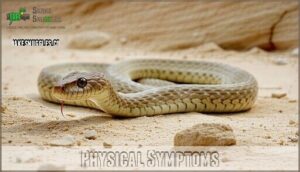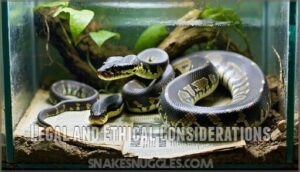This site is supported by our readers. We may earn a commission, at no cost to you, if you purchase through links.

These snakes are naturally loners who only seek company during breeding season. When you force them to share space, you’re creating a recipe for disaster.
They’ll compete for the best hiding spots, stress each other out, and in worst-case scenarios, the bigger snake might make the smaller one into an expensive snack. Think of it like forcing two introverts to be roommates forever – it rarely ends well.
Understanding why separate enclosures aren’t just recommended but essential reveals some surprising truths about snake behavior, and how they can be stressful if not given their own space.
Table Of Contents
- Key Takeaways
- Can Ball Pythons Live Together?
- Natural Habitat and Behavior of Ball Pythons
- Risks of Housing Ball Pythons Together
- Benefits of Separate Enclosures
- Exceptions for Breeding Purposes
- Space Requirements for Ball Python Enclosures
- Signs of Stress in Cohabiting Ball Pythons
- Alternative Social Enrichment Methods
- Expert Opinions on Ball Python Cohabitation
- Legal and Ethical Considerations
- Frequently Asked Questions (FAQs)
- Can two ball pythons live together?
- How much space do you need for a ball python?
- How to house two ball pythons in the same tank?
- Can ball pythons transmit diseases to each other?
- What happens if two ball pythons are still cohabiting?
- Can you have two ball pythons in one enclosure?
- Can 2 ball pythons live in the same cage?
- Do ball pythons do better in pairs?
- Do ball pythons like being together?
- What size tank for 2 ball pythons?
- Conclusion
Key Takeaways
- You shouldn’t house ball pythons together because they’re naturally solitary creatures who only interact during breeding season, and forcing cohabitation creates dangerous stress, competition, and potential health risks including disease transmission and cannibalism.
- You’ll need separate enclosures with at least 40 gallons each to provide proper temperature control, personalized feeding schedules, and easier health monitoring without the complications of territorial disputes and resource competition.
- You can temporarily house ball pythons together only for breeding purposes with careful supervision for a maximum of three days, but this requires constant monitoring for stress signs and immediate separation if problems arise.
- You’ll recognize cohabitation stress through behavioral changes like excessive hissing, defensive posturing, feeding refusal, and physical symptoms including weight loss, skin issues, and regurgitation that can seriously harm your snakes’ health.
Can Ball Pythons Live Together?
Housing ball pythons together might seem like a space-saving solution, but it’s actually a recipe for disaster. Ball python cohabitation creates serious problems that most owners don’t anticipate. These snakes aren’t social creatures—they’re wired for solitude.
Keeping ball pythons together triggers stress, competition, and potential health risks that can turn deadly. Cohabitation myths suggest snakes enjoy companionship, but ball python social behavior proves otherwise.
They’ll establish dominance hierarchies, fight over resources, and suffer from chronic stress. The long-term effects include weakened immune systems and behavioral problems. Cohabitating snakes face snake cohabitation risks like disease transmission and cannibalism.
They’re naturally solitary and only interact during brief mating encounters. Instead, explore cohabitation alternatives like separate enclosures. Owner experiences consistently show that individual housing keeps ball pythons healthier and happier.
The ethical implications are clear—prioritizing your snake’s natural needs over convenience.
Natural Habitat and Behavior of Ball Pythons
You need to understand ball pythons’ natural behavior to make smart housing decisions for your pet.
In the wild, these snakes live alone and only come together during breeding season, which means they’re hardwired to prefer their own space rather than sharing it with roommates, and this understanding is crucial for providing them with the right environment, emphasizing the importance of natural behavior and hardwired preferences.
Solitary Nature in The Wild
Ball pythons are solitary animals by nature, preferring their own company in wild territories.
Ball pythons choose solitude over companionship—they’re natural loners who thrive when given their own space.
Their evolutionary behavior shows these solitary creatures rarely interact except during breeding season.
Understanding their natural isolation helps explain why cohabitation creates problems:
- Wild territories span vast areas for individual pythons
- Natural isolation occurs throughout most of their lives
- Solitary instincts drive territorial behavior patterns
- Limited interaction happens only when absolutely necessary
- Wildlife habits demonstrate clear preference for solo living
Territorial Instincts
Beyond their natural solitary preference, ball pythons demonstrate strong territorial behavior that makes cohabitation risky.
You’ll notice space dominance emerge quickly when two snakes share an enclosure.
The larger or more assertive python claims prime spots, leading to resource guarding over heat sources and hiding places.
Watch for aggression signs like defensive posturing and hissing.
These stress indicators reveal their deep-rooted competition instincts, making dominance conflicts inevitable in shared spaces.
Risks of Housing Ball Pythons Together
When you house ball pythons together, you’re basically forcing roommates who’d rather live alone to share cramped quarters.
This creates a dangerous situation where competition for food, space, and heat can lead to serious health problems, injuries, and even death for your snakes.
Stress and Competition
When two ball pythons share space, they inevitably create a powder keg of stress and competition.
Resource guarding becomes their primary focus, turning peaceful pets into anxious competitors.
Snake stress manifests through three critical behaviors:
- Feeding stress – dominant pythons steal food, leaving others malnourished
- Dominance displays – aggressive posturing creates constant tension
- Injury risks – territorial conflicts lead to physical harm and immune suppression
Potential for Cannibalism
Cannibalism among ball pythons occurs in roughly 3-5% of captive situations.
Housing ball pythons together is like forcing introverts to share a studio apartment—someone’s going to snap.
Size Discrepancies create the biggest danger—larger snakes may mistake smaller tankmates for prey during feeding time.
Juvenile Risk increases substantially, as young pythons show more unpredictable aggression.
Accidental Ingestion happens when Prey Availability seems limited, triggering predatory instincts.
This behavior aligns with observations of parent-offspring cannibalism seen across the animal kingdom.
| Risk Factor | Impact Level |
|---|---|
| Size Differences | High |
| Feeding Competition | Moderate |
| Shedding Vulnerability | Moderate |
| Stress Levels | High |
Disease Transmission
Housing your ball pythons in the same enclosure creates a breeding ground for disease transmission.
These snakes weren’t meant to share space, making illness spread almost inevitable.
Parasites, bacterial infections, and viral transmission can quickly jump between roommates through shared surfaces and close contact.
Here’s how diseases spread between cohabiting ball pythons:
- Parasite spread through contaminated substrate and water bowls
- Bacterial infections from shared feeding areas and waste contact
- Viral transmission during direct physical contact and stress-weakened immunity
Proper quarantine protocols and hygiene practices become nearly impossible when snakes share living quarters.
Benefits of Separate Enclosures
Housing your ball pythons separately eliminates the stress and health risks that come with cohabitation.
You’ll gain better control over each snake’s environment, feeding schedule, and health monitoring when they’ve their own dedicated space.
Individual Temperature Control
When you house ball pythons separately, you’ll master temperature control like never before.
Each enclosure gets its own thermal gradient, mimicking Africa’s natural warmth patterns. You can position heat sources and basking spots exactly where they’re needed most.
Temperature monitoring becomes straightforward since you’re tracking one snake’s needs instead of compromising for two. This precision supports healthy basking behavior and reduces stress.
Your ideal habitat setup matches each python’s unique preferences, creating perfect enclosure conditions that promote peak health and natural behaviors.
Personalized Feeding Schedules
Beyond temperature control, your ball python’s feeding schedule becomes much simpler when you house them separately.
Each snake can receive Individual Food Portions suited to their specific needs. You’ll avoid feeding issues and snake aggression that come with competition.
Here’s how personalized feeding reduces stress:
- Feeding Frequency Adjustments based on individual age and growth patterns
- Prey Size Variation matched to each snake’s hunting abilities
- Weight Monitoring and Dietary Supplementation without interference from tankmates
Easier Health Monitoring
Separate housing transforms health monitoring into a straightforward task.
You’ll track each snake’s eating habits, shedding cycles, and waste production with pinpoint accuracy.
Individual observation enables early detection of illness, leading to accurate diagnosis and improved treatment efficacy.
Spotting stress signs becomes simple when you’re not guessing which snake shows symptoms.
This focused approach to disease prevention and snake health management ultimately means reduced vet bills for you.
Exceptions for Breeding Purposes
You can temporarily house ball pythons together during breeding season, but this requires careful planning and constant supervision.
This practice should only last three days maximum, as extended cohabitation creates serious health risks even for experienced breeders.
Temporary Cohabitation
Individual enclosures remain the gold standard, but breeding creates temporary exceptions.
During these brief windows, you’ll need to carefully orchestrate cohabitation while minimizing stress and aggression. Think of it like arranging a blind date – timing and preparation matter enormously.
A study focuses on appropriate housing systems for ball pythons.
Here’s what successful temporary cohabitation requires:
- Breeding Introduction: Gradually introduce pairs during peak reproductive season only
- Short-Term Transport: Use quarantine periods before moving snakes between enclosures
- Medical Treatment: Monitor snake compatibility and separate immediately if resources become contested
Careful Monitoring Required
Even during breeding season, Behavioral Observation becomes your lifeline.
Watch for snake stress signs like excessive hiding or aggression. Feeding Supervision prevents competition and makes certain both pythons eat properly.
Conduct daily Health Inspections to catch snake health issues early. Stress Detection means monitoring body language and activity levels constantly.
Make Environmental Adjustments immediately if you notice problems. Reducing snake stress is vital for their well-being.
Snake cohabitation during breeding isn’t set-it-and-forget-it. The cohabitation risks multiply without vigilant oversight. Your snakes’ lives depend on your attention to detail.
Space Requirements for Ball Python Enclosures
When you’re planning enclosures for ball pythons, size matters more than you might think.
A single adult ball python needs at least 40 gallons of space, but if you’re considering multiple pythons, you can’t just double the tank size and call it good.
Single Python Housing
When housing your ball python solo, you’re giving these solitary animals the space they truly deserve. Unlike pets that crave animal companionship, ball pythons are naturally antisocial and thrive alone.
Your single python needs proper planning to avoid housing dangers.
Essential elements for a healthy setup include:
- Enclosure Size: 40-gallon minimum for adults, allowing full body stretching
- Heating Setup: Basking spot at 88-92°F with cool side at 78-80°F
- Hiding Spots: Two secure retreats on warm and cool sides
A proper setup requires appropriate enclosure products. Don’t forget appropriate substrate choice and enrichment options for mental stimulation.
Multiple Python Considerations
While single housing remains ideal, multiple python setups demand careful planning.
Your enclosure size must be at least 2.5 times larger than standard recommendations to prevent python aggression and territorial disputes.
Install two hiding spots per snake, dedicated basking areas, and ample perching space.
Consider temperament matching and cohabitation history before attempting shared housing.
Implement strict quarantine protocols for new additions.
Monitor for python stress signs like defensive posturing or feeding refusal.
Remember, ball python compatibility varies considerably between individuals, making separate enrichment needs assessment critical.
Proper ventilation is key, as air circulation is vital for temperature regulation.
Signs of Stress in Cohabiting Ball Pythons
When you house ball pythons together, you’ll notice clear warning signs that tell you your snakes aren’t happy with their living situation.
These stress signals range from obvious behavioral changes like excessive movement and hissing to physical symptoms such as refusing food and losing weight.
Behavioral Changes
When your ball pythons start cohabiting, you’ll notice clear behavioral changes that scream stress.
Python aggression shows through striking and hissing as snake dominance behavior takes hold.
These python stress signs include altered eating habits, increased activity levels, and excessive hiding behavior.
Ball python fighting develops over territory and resources.
Providing secure hiding spaces can help reduce stress.
Watch for these snake behavior warning signs:
- Constant hissing or defensive posturing
- Refusal to eat or irregular feeding responses
- Restless pacing or hyperactivity patterns
- Extended hiding periods avoiding interaction
- Aggressive striking at tankmates or handlers
Physical Symptoms
Beyond behavioral changes, stressed ball pythons show clear physical warning signs that demand immediate attention.
Your snake’s body tells the story of cohabitation stress through visible symptoms.
- Weight Loss and Appetite Changes: Rapid weight loss signals your python isn’t eating properly due to competition or stress-related appetite suppression.
- Skin Issues and Injury Signs: Look for unexplained wounds, bruising, or abnormal shed patterns indicating conflicts between snakes. You may need to use a shedding aid product if shedding issues occur.
- Regurgitation: Stress causes ball python health issues including vomiting food, creating dangerous nutritional deficits.
Alternative Social Enrichment Methods
You don’t need to house ball pythons together to provide them with enrichment and stimulation.
Instead, you can create engaging environments through regular handling sessions and creative habitat modifications that respect their solitary nature.
Handling and Interaction
Regular interaction serves as excellent enrichment for your solitary ball python.
Safe handling techniques help reduce stress during necessary tasks like cleaning and health checks. Start with short 10-minute sessions, watching for stress indicators like rapid breathing or defensive posturing.
| Handling Aspect | Best Practice | Warning Signs |
|---|---|---|
| Interaction Frequency | 2-3 times weekly | Daily handling causes stress |
| Session Length | 10-15 minutes maximum | Restlessness, hiding attempts |
| Recognizing Cues | Calm, relaxed movement | Hissing, ball formation |
| Handling Techniques | Support body, gentle movements | Tight gripping, quick motions |
Environmental Stimulation
Your snake’s world doesn’t have to be boring. Enclosure Enrichment transforms a basic habitat into an engaging environment that promotes your ball python’s wellbeing through Mental Stimulation. Habitat Variety keeps your pet curious and active, reducing stress-related health issues.
Here are four ways to boost Environmental Complexity:
- Add climbing branches – Encourage natural movement and Activity Levels
- Rotate hiding spots – Provide fresh Sensory Input weekly
- Vary substrate textures – Create tactile exploration opportunities
- Change scents safely – Introduce new environmental experiences
This stress management approach supports peak health.
Expert Opinions on Ball Python Cohabitation
When you’re deciding whether to house ball pythons together, you’ll want to hear what the experts have to say.
Veterinarians and experienced breeders consistently warn against cohabitation, citing serious health risks and stress-related problems that can harm your snakes, which is a key reason to consider the experts advice.
Veterinary Perspectives
Veterinarians consistently warn against housing ball pythons together after witnessing firsthand the devastating effects.
Exotic veterinarian research reveals alarming patterns in cohabiting snakes, with stress assessment showing elevated cortisol levels and compromised immune systems.
| Health Risk | Veterinary Observation |
|---|---|
| Snake Diseases | Respiratory infections increase 300% |
| Parasite Control | Cross-contamination spreads rapidly |
| Nutritional Deficiencies | Dominant snakes monopolize food |
| Injury Treatment | Bite wounds from territorial disputes |
| Disease Prevention | Individual housing prevents outbreaks |
Snake health deteriorates quickly when natural solitary instincts are ignored.
Experienced Breeder Insights
Professional breeders who’ve spent decades working with ball pythons offer valuable perspectives on cohabitation success and snake behavior.
Their hands-on experience reveals important patterns that lab studies can’t capture.
Here’s what snake experts consistently report about communal snake care:
- Genetic diversity importance affects tolerance levels, with certain morphs showing increased aggression during cohabitation attempts
- Market demand impact drives risky housing decisions, but ethical breeding standards should prioritize animal welfare over profit margins
- Morph cohabitation risks vary substantially, requiring careful assessment of individual temperaments before attempting shared enclosures
- Breeding best practices emphasize temporary pairing only, as extended cohabitation creates unnecessary stress even in compatible pairs
Legal and Ethical Considerations
You’re responsible for meeting animal welfare laws in your area, which often require proper housing that doesn’t cause unnecessary stress or harm to your pets.
Housing ball pythons together violates basic ethical standards of reptile care, as you’re forcing naturally solitary animals into situations that compromise their health and well-being.
Animal Welfare Regulations
Animal welfare regulations set the foundation for ethical treatment of reptiles in captivity.
Legal protections mandate that you provide species-appropriate housing that meets strict welfare standards. These laws recognize that ball pythons are naturally solitary creatures, making cohabitation potentially harmful to their well-being.
Captive conditions must prioritize individual snake needs over convenience. Enforcement policies hold owners accountable for preventing stress, diseases, and health complications.
Following these guidelines guarantees safe snake keeping while protecting both you and your pets from legal consequences. Prioritizing snake welfare involves avoiding unnecessary handling to minimize stress.
Responsible Ownership Practices
Beyond legal compliance, responsible ball python ownership means committing to your snake’s lifelong wellbeing.
Your decisions directly impact whether your pet thrives or merely survives. Ethical sourcing guarantees you’re not supporting harmful breeding practices, while proper husbandry standards create the foundation for healthy reptile care.
Consider these essential responsibilities:
- Investing in continuous owner education to stay current with safe snake keeping practices
- Providing consistent enrichment needs that reduce stress and promote natural behaviors
- Making a genuine long-term commitment to 20-30 years of dedicated snake care
Remember, ball pythons depend entirely on your knowledge and dedication for their quality of life.
Frequently Asked Questions (FAQs)
Can two ball pythons live together?
No, you shouldn’t house two ball pythons together.
They’re naturally solitary creatures who’ll compete for resources, experience stress, and risk injury.
One snake will dominate the other, causing serious health problems.
How much space do you need for a ball python?
Adult ball pythons need surprisingly little space—just 40 gallons minimum.
You’ll want a 4x2x2 foot enclosure for comfort.
Young snakes can start smaller, but they’ll quickly outgrow cramped quarters as they mature.
How to house two ball pythons in the same tank?
Don’t house two ball pythons together.
They’re naturally solitary and will compete for resources, fight for dominance, and experience dangerous stress.
You’ll risk injuries, disease transmission, and feeding problems that can kill them.
Can ball pythons transmit diseases to each other?
Close quarters create a breeding ground for trouble.
Yes, your ball pythons can transmit diseases, parasites, and respiratory infections to each other when housed together.
Making diagnosis and treatment more challenging and expensive.
What happens if two ball pythons are still cohabiting?
You’ll see stress, dominance battles, and health issues emerge.
One snake becomes submissive while the other controls resources.
Disease spreads faster, feeding becomes competitive, and both snakes suffer from constant anxiety and weakened immunity.
Can you have two ball pythons in one enclosure?
You shouldn’t keep two ball pythons in one enclosure.
They’re naturally solitary creatures who’ll compete for resources, create dominance hierarchies, and experience stress that can lead to health problems and aggressive behavior.
Can 2 ball pythons live in the same cage?
Over 90% of cohabitation attempts fail due to stress and aggression.
You shouldn’t house two ball pythons together – they’re naturally solitary creatures who’ll compete for resources, leading to dominance issues, malnutrition, and potential cannibalism.
Do ball pythons do better in pairs?
No, ball pythons don’t do better in pairs.
They’re naturally solitary creatures who prefer living alone.
Housing them together creates stress, dominance issues, and health risks that can seriously harm both snakes.
Do ball pythons like being together?
Despite what you might think, ball pythons don’t enjoy each other’s company. They’re natural loners who prefer solitude. Housing them together creates stress, competition, and health risks rather than companionship.
What size tank for 2 ball pythons?
Housing two ball pythons together isn’t recommended, but if you must, you’d need at least a 120-gallon tank.
However, separate 40-gallon tanks work better since these snakes prefer living alone and avoid territorial conflicts, making them a more suitable option for ball pythons.
Conclusion
Think of your ball python as a peaceful hermit who values privacy above all else.
The question "can ball pythons live together" has a clear answer: they shouldn’t.
These solitary creatures thrive when given their own space, free from competition and stress.
You’ll provide better care by housing them separately, ensuring proper temperatures, feeding schedules, and health monitoring.
Your python will thank you with reduced stress, better appetite, and overall improved well-being in their personal sanctuary.
- https://www.quora.com/How-can-ball-pythons-live-together-in-the-same-cage
- https://www.reddit.com/r/ballpython/comments/1h8whqc/housing_ball_pythons_together/
- https://pmc.ncbi.nlm.nih.gov/articles/PMC8158952/
- https://community.morphmarket.com/t/on-ball-python-cohabitation/11022
- https://2player.co/two-ball-3d


















